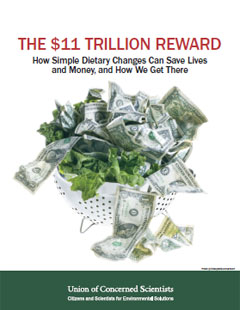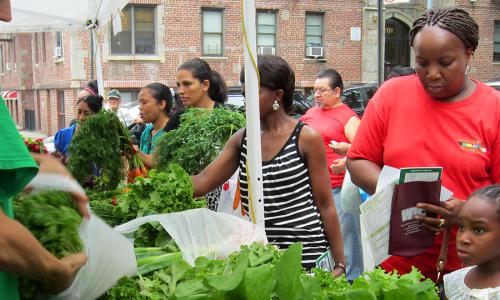It turns out that an apple a day really can keep the doctor away—especially if she's a cardiologist.
According to a 2013 UCS report, The $11 Trillion Dollar Reward, increasing our consumption of fruits and vegetables could save more than 100,000 lives and $17 billion in health care costs from heart disease each year.
And better farm policies, designed to encourage production of healthy food instead of processed junk foods, will help us reap those benefits.
Healthier food, healthier hearts: the surprising numbers
Here are some of the more eye-opening findings from the report:
- Medical costs of treating heart disease and stroke were estimated at $94 billion in 2010, and this figure is projected to nearly triple by 2030.
- If Americans ate just one more serving of fruits or vegetables per day, this would save more than 30,000 lives and $5 billion in medical costs each year.
- If Americans were to follow current USDA recommendations for daily consumption of fruits and vegetables, those numbers would go up to more than 127,000 lives and $17 billion saved.
- According to methods commonly used by economists, the increased longevity that would result if Americans ate the recommended amount of fruits and vegetables is worth over $11 trillion.
Local food to the rescue
One good way to get more fruits and vegetables into our diets is to increase our access to locally grown food.
Local food systems are good for the economy. And it turns out that they are good for our hearts as well. Here's why:
- Fruits and vegetables constitute 65 percent of locally sold food.
- Evidence is emerging that access to local-food markets increases fruit and vegetable consumption.
- Relatively modest investments should go a long way toward promoting the future growth of local-food markets.
Time to invest in healthy food
We know that eating more fruits and vegetables will save lives and money. What do we do next?
First, we should make federal policy work for, not against, farmers who want to grow healthy food:
- Change our research priorities. More research funding for healthy foods could translate to more abundant, varied, and affordable fruits and vegetables for consumers.
- Remove planting restrictions. Many commodity crop farmers are barred under current subsidy programs from planting fruits and vegetables. Lifting those restrictions would help create more competitive market conditions for healthy foods.
- Make crop insurance available. Crop insurance is currently unavailable for many fruit and vegetable farmers, making it harder to grow healthy foods profitably. Removing this obstacle should be a priority.
Second, we should make healthy, locally grown food more available and affordable to consumers:
- Promote the growth of farmers markets, food hubs, and other local food outlets—especially in underserved areas where access to healthy food is most limited—through grants and low-interest loans.
- Facilitate the use of nutrition benefits such as SNAP (Supplementary Nutrition Assistance Program) at local-food markets.
- Educate consumers about healthy foods and how to prepare them.







